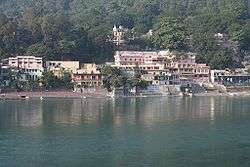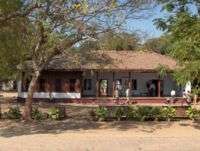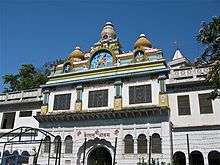Ashram
Traditionally, an ashram[1] (Sanskrit: ashrama or ashramam) is a spiritual hermitage or a monastery in Indian religions.[2][3]


Etymology
The term ashram (Sanskrit: आश्रम, Sanskrit pronunciation: [aːɕɽɐmɐ]) comes from the Sanskrit root śram- (श्रम्) ('to toil').[4] According to S. S. Chandra, the term means "a step in the journey of life".[5] In contrast, according to George Weckman, the term ashram connotes a place where one strives towards a goal in a disciplined manner. Such a goal could be ascetic, spiritual, yogic or any other.[6]
Overview

An ashram would traditionally, but not necessarily in contemporary times, be located far from human habitation, in forests or mountainous regions, amidst refreshing natural surroundings conducive to spiritual instruction and meditation. The residents of an ashram regularly performed spiritual and physical exercises, such as the various forms of yoga. Other sacrifices and penances, such as yajnas, were also performed.[7] Many ashrams also served as gurukulas, residential schools for children under the guru-shishya tradition.
Sometimes, the goal of a pilgrimage to the ashram was not tranquility, but instruction in some art, especially warfare. In the Ramayana, the princes of ancient Ayodhya, Rama and Lakshmana, go to Vishvamitra's ashram to protect his yajnas from being defiled by emissary-demons of Ravana. After they prove their mettle, the princes receive martial instruction from the sage, especially in the use of divine weapons. In the Mahabharata, Krishna, in his youth, goes to the ashram of Sandipani to gain knowledge of both intellectual and spiritual matters.
Schools in Maharashtra
Boarding schools, especially in the tribal areas of Maharashtra and elsewhere in India, are called ashram shala or ashram schools. One such school is the Lok Biradari Prakalp Ashram Shala.[8][9]
In the West

A number of ashrams have been established outside India. Typically, these ashrams are connected to Indian lineages,[10] focus on imparting Yoga-related teachings, often in residential retreats, and are headed by spiritual teachers (Indians or Western).
References
- "Ashram". Cambridge English Dictionary. Retrieved 4 December 2019.
a place where a group of Hindus live together away from the rest of society, or a place where Hindus can go in order to pray
- Swami Swahananda (1 January 1990). Monasteries in South Asia. Vedanta Press. pp. 92–. ISBN 978-0-87481-047-9.
- Mayeul de Dreuille (1999). "1 Hindu mansticism". From East to West: A History of Monasticism. Gracewing Publishing. pp. 3–27. ISBN 978-0-85244-464-1.
- Harper, Douglas. "ashram". Online Etymology Dictionary.
- S.S. Chandra; S.S. Chandra & Rajendra Kumar Sharma (1996). Philosophy of Education. Atlantic Publishers & Dist. pp. 173–. ISBN 978-81-7156-637-2.
- George Weckman (2000). William M. Johnston (ed.). Encyclopedia of Monasticism: A-L. Routledge. p. 94. ISBN 978-1-57958-090-2.
- Gopal, Madan (1990). K. S. Gautam (ed.). India through the ages. Publication Division, Ministry of Information and Broadcasting, Government of India. p. 70.
- Hetal Vyas (31 January 2009). "Shocked HC files suo-motu PIL over ashram rape and deaths". PuneMirror. Archived from the original on 2011-07-18. Retrieved 2009-03-17.
- "Lok Biradari Prakalp". Lok Biradari Prakalp. 2009. Retrieved 2009-03-17.
- "200 hours Yoga teacher training course in Rishikesh India". yogadaindia.com. Retrieved 2018-04-23.
External links

